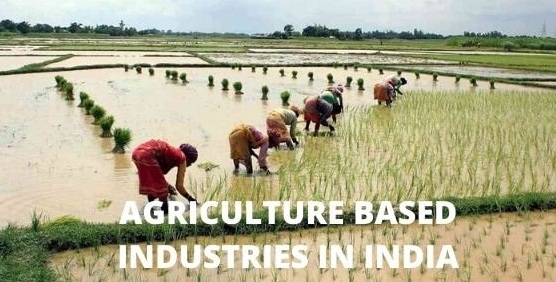STATUS OF MAJOR AGRO INDUSTRIES IN INDIA

By Professor Dr. P. K. Jena
India since 1950, while putting lots of emphasis on production of various agricultural crops, has started in a modest way the agro processing industries. However, these industries particularly in rural areas, have been facing problems like low capacity utilization, poor recovery of finished products from raw materials, want of adequate working capital, low quality product, inefficient management, frequent disruption of electricity and water supply etc. In order to boost the development of agro industries in keeping with increasing agricultural production, the central as well as concerned state governments should take all measures to create a conducive atmosphere for these industries. However, a brief account of the present status of some of major agro industries in India is given below.
i) Rice Products
Rice production during 1950 to 2000, has increased from 20.6 million tons (MT) to about 89 MT. During this period, the technology in this area, has also under gone significant changes from hand pounding and pedal operated system to modern rice mills using rubber rolls for paddy de-husking. At present, out of about 30,000 modern rice mills, more than 5,000 large ones with parboiling facility are in operation. Innovations in processing of rice include improved parboiling, continuous flow LSU type and tray drying. Thermic fluids are used as medium of heat transfer for heating the air used for drying in a large number of rice mills. The value added products of rice include puffed and flex rice used as snack foods. The packaging technology for milled rice for ready to cook, has been developed for domestic market and export. Quick cooking rice technology has been developed for supplying to defense personnel. Rice is cooked and packed under highly sanitary condition and supplied for safe use up to six months. Rice bran oil is produced to use as edible oil and for soap making. Using rice husk as source of fuel as it is being practice currently in rice mills, is not advisable as more value added products can be obtained from this. Efforts are being made to use rice husk for producing furfural, high grade silicon, insulation material, particle board etc.
ii) Wheat products
In the year 2000, India produced about 76 MT of wheat and was the second largest producer in the world. Wheat contains 12% bran, 3% embryo and 85% flour and is processed for producing Atta, Maida, Suji and Dalia. Wheat is now being used in every household in India in form of Atta, Suji, Bread, Biscuit etc. In the area of wheat milling, mini flour mills with higher efficiency in small scale have been developed. Traditionally used small size atta chakkis are being replaced by better mechanized chakki with lower pollution label with better efficiency. The number of roller flour mills is also increasing steadily with increasing demand for bread and biscuit. However, the demands for bread is likely to grow faster than that of biscuits. Among diversified wheat products, full bran wheat bread is gaining popularity. A number of developments are needed in this area so that more agro industries can come up in near future.
iii) Pulses Based Industry
India’s production of pulses in the beginning of the century was about 14 MT. In the country, there are about 15 thousand Dhal mills of 100 to 500 tones per day capacity. In Dhal industry, the pulses are subjected to temperature of about 120 o C for a short period and then dehusking is done by carborundum rollers. However, for small entrepreneurs in rural areas, small dhal mills have been designed and are used. In some major dhal mills, improved machinery including cleaners, graders, magnetic separators, washers, dryers, polishers, colour shorter and packing systems are being used. In recent years, some more efficient machines have been developed to improve recovery and economize energy consumption. There is a need to develop technology for quick cooking and ready to eat dal such as ‘Instant Dal’.
iv) Oil Seed Based Industry
In India, different types of oil or hydrogenated oil (Vanaspati) are being used in every household. In the country, per capita consumption of oil is about 8 kg. per year and out of this 2 kg. per capita is imported oil. In the beginning of the century, production of oil seeds in the country was about 24.5 MT. Out of the total production, about 7% is used for seed, 8% for food and 85% for oil extraction. Earlier processes of extracting oil from oil seeds were in bullock operated oil ghanies or mechanical oil expellers. In such process, good amount of oil is left in the cake. In 2000-2001, there were nearly 2.5 lakhs oil ghanies, 6000 oil expellers and 700 solvent extraction plants. In addition to these, there were about 200 oil refining units and about 100 hydrogenated oil production units. At present, efforts are being made to improve the extraction of oil from oil seeds through various pretreatments like steaming. Recently, some developments have been made in design of bullock operated ghanies to make these suitable for operating on 1.5 Kw electric motor. In this way, ghanies oil production capacity has increased. The pungent oil generally produced in ghanies, are some times mixed with oil that is obtained from mechanical oil expellers to suit the tastes of some section of people. Solvent extraction of edible oil is done by using food grade hexane. Due to shortage of oil seeds to get the required amount of oil, some edible oil from non traditional sources including rice bran and palm oil is produced and used. Besides other oil seeds, soyabean has become an important crop in India with annual production of about 5.3 MT at present. Soyabean contains 48% proteins and 20% oil. It is suggest that, soya food being nutritious and economical, its production should be promoted. It is reported that, oil seed cake worth about Rs.15,000/- million is being exported at present. Instead of exporting, these should be processed in the country to produce value added food products. In the areas of packaging, edible oil polypacks and plastic container have gained popularity over metal containers.
v) Sugarcane Based Industry
Sugarcane Based industry is one of the major ones in India. In 2000-2001, India produced about 3 MT of sugarcane, out of which about 80% of the cane is milled. At present, about 50% of sugarcane harvested in India is used to produce refined white sugar and the rest for production of Gur and Khandsari. For producing Gur, the canes are crushed and juice is clarified and concentrated. Gur has got better nutritional value than white sugar. Energy efficient furnaces, concentration pans, clarificants, moulds and storage facility are needed for making the product better and cheaper.
The wastes obtained in sugar industries include bagasse, dry leaves and molasses. At present, sugar industries meet their energy requirement mostly through burning of bagasse in boilers-steam turbine units. However, it is more wise to use cheaper types of fuels in such units and save most of the bagasse for paper industries. The bagasse is a very good raw material for producing high quality paper.
vi) Fruits and Vegetables based Industries
India is considered to be a major producer of fruits and vegetables in the world. During 2000-2001, India produced about 45 MT of fruits and 80 MT of vegetables. However, due to lack of various infrastructures including cold storage facility, large amounts of these get wasted. In 2000, there were about 6,000 fruits and vegetables processing units in India. It is reported that, food processing units has grown steadily from 0.27 MT in 1980 to about 3 MT in 2000. This has been possible by adopting developed technology in processing. Significant developments in technology in areas of ripening of fruits, optimum harvesting time, cold storing, cleaning, waxing, packaging etc. have taken place. The value added agro industries include jam, jelly and pickle products. However, some technology is still being imported for establishing large scale export oriented units for production of food items like banana paste, concentration of food juices, sorting, clearing, waxing and packaging of raw fruits and vegetables. By the end of the period 1998-1999, the share of different products in processing of fruits and vegetables were pulp and juice 27%, jams and jelly 10%, pickles 12%, ready to serve beverages 13%, syrups 8%, squash 4%, tomato product 4%, canned vegetables 4% and other products 18%. The fruits and vegetable industries are facing problems like technological obsolescence, low capacity utilization and marketing.
vii) Meat & Fish Industries
In India, agro industries based raw materials like meat, poultry and fish are not in tune with the requirements. Meat and poultry production in India together, has been about 4.6 MT per year with goat and sheep contributing 54%, buffalo and cattle 20%, poultry 13% and pig 7%. In addition, a large amount of potentiality is there for pisciculture in rivers and ponds as well as catching fish from sea. The country has got 7500 km long coastal line and an exclusive economic zone of 2.02 million square kilometers, 1,91,024 km of rivers and canals and 4.4 million hector of reserves and fresh water lakes thus providing enormous potentiality for fishing. Most of the meat, fish and poultry in India are used as fresh or in dried form. However, modern technologies for processing meat and fish have not been satisfactorily utilized for processing and canning these. Due to unsatisfactory conditions and non-availability of proper infrastructure, the processing industries in India in these areas are very few and export is limited.
viii) Industries based on Spices, Nuts, Coconuts etc
In India, commercial crops like spices, water chestnut, beetle leaves, tobacco, coconut, aromatic and medicinal plants etc. though produced in large quantities, the post harvest operation is highly energy intensive. Further, quality control through proper cleaning, grading, dehydrating etc. is not very satisfactory. India is a leading producer of spices including black peeper, cardamom, chilies etc. The country produces about 3 MT of spices worth 60,000 Million rupees out of which only 7% is exported. India has to utilize modern technology to improve production as well as processing these items. Export of coconut in 1996-97 from India, has earned foreign exchange worth Rs.1.72 billion. The coconut based industries in India is at infancy stage. There is a great scope to produce various coconut based products like coconut milk and milk powder, coconut cream, coconut shell charcoal etc. mainly for export purpose. Similarly, essential oils and other value added products from cultivation of aromatic and medicinal plants have a bright export potential.
ix) Paper Industry
India with it’s vast population and increasing literacy, needs large amounts of paper for various purposes including news print and writing papers. In addition, in recent years, there is an increasing demand of various types of papers like tissue paper, medical grade coated paper, tea bags, filler paper etc. Therefore, the country needs to produce large amounts of different grades of paper using various raw materials like bamboo, soft wood, bagasse etc. In India, per capita consumption of paper is just 5 kg. per annum whereas, it is 337 kg. In North America, 110 kg. in Europe and 30 kg. in China. Indian paper industry is rated as 15th largest in the world engaging about 1.5 million people. There are a number of problems for which the paper industry in India is not growing to fulfill the requirements in the country. Some of these are (i) dearth of good quality raw materials, along with their high cost (ii) Adoption of back dated technology for producing different type of paper (iii) Rising cost of transportation and power. (iv) High import duty on pulp and waste paper, wood raw materials etc (v) Lack of efforts for quality improvement and control and (vi) Unsatisfactory rehabilitation packages for large number of small scale paper manufacturing units.
In view of this, it is necessary to take immediate steps to solve these problems through large scale plantation of bamboo, softwood etc., facilitating import of pulp and waste paper, developing better technology, infrastructure and skilled manpower.
x) Jute and Cotton Base Industry
Cotton based agro industries in India have not made the expected impacts in our socio economic developments. The traditional cotton textile industry could not make much impact compared to the modern units with high speed spinning, weaving and surface finished technology. Swadeshi, khadi and village industries commission has been assisting small scale industries in India. However, these small scale cotton industries very often face labour and technology problems. In view of this, it is suggested that, government should provide modern technology and incentives to cotton textile based small and medium scale industries. In addition to this, a number of agro industries based on wastes and bi-products of cotton plants should come up. For Example, the stalks of cotton plants can be utilized to produce paper and pulp, particle boards and micro crystalline cellulose (MCC). Cotton willow dust can be used for production of biogas and cotton waste can be used in mushroom cultivation.
The jute is produced mostly in eastern part of India. The jute based products are highly labour intensive. Mini jute carding and spinning mills have been developed in the country. For each ton of jute, 2 to 3 tons of jute stick are produced. These sticks are generally used as fuel wood. However, there is a great scope to utilize these sticks for producing excellent particles board and the technology has been commercialized. Jute sticks can also be used as a good raw material for producing paper pulp.
Conclusion
Nearly 70% of the population of India live in villages. Most of these people depend on agriculture for their living. The living standard as well as their socio economic condition are very much less compared to those living in urban and industrial areas of the country. Many of them are unemployed. The agro industries based on their respective agricultural products while giving more employment opportunities can improve their socio economic conditions.
In India, the agro industry projects which were introduced during 1960s with close linking with agricultural products did not materialize due to various reasons. Rather, emphasis was given for providing aids for setting up individual production units instead of developing these industries area wise. This trend has to be suitably rectified to create proper atmosphere for growth of agro industries. However, favourable atmosphere should be created so that the farmers should be encouraged to form cooperatives for smoothly running their agro industries based on specific crops produced by them. The government should provide them most recent technology, cold storage facilities and the market.
The author is former Director General, Council of Scientific & Industrial Research, India. He is at present Chairman, Institute of Advance Technology & Environmental Studies (IATES). He can be reached prof.pkjena_iates@yahoo.com







